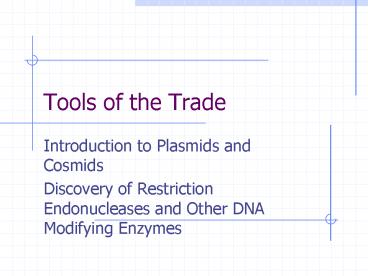Tools of the Trade PowerPoint PPT Presentation
1 / 19
Title: Tools of the Trade
1
Tools of the Trade
- Introduction to Plasmids and Cosmids
- Discovery of Restriction Endonucleases and Other
DNA Modifying Enzymes
2
Plasmids
- Plasmids are like Mini-chromosomes
- Covalently closed circular
- Autonomous replication
- All plasmids have an origin of replication (ori)
and genes.
3
Plasmids
- Differs from chromosomes
- One or more copies (700)
- Not all bacteria have plasmids
- Range in size from 1200 kbp (kilobase pairs)
- Functions
- Cryptic no known function
- Phenotypic antibiotic resistance, conjugative,
virulence, etc.
4
The 1950s and 1960s
- Saw great breakthroughs in DNA enzymology
- 1955 - Arthur Kornberg and Severo Ochoa isolated
DNA polymerase I (1959, Nobel) - B. Weiss and C.C. Richardson isolated DNA ligase
(1966) - H.O. Smith, K.W. Wilcox, and T.J. Kelley isolated
and characterized the first sequence specific
restriction nuclease (1968)
5
(No Transcript)
6
DNA Transformation More Discoveries
- In the 1950s people observed that DNA introduced
into different strains of Escherichia coli (E.
coli) would not always replicate well in all
strains. - 1966, chemical analysis of small viral DNA that
survive in bacteria were shown to be methylated. - Methylation was achieved enzymatically.
7
Late 1960s
- Stewart Linn and Werner Arber isolated
- Methylase
- A random Restriction nuclease
- Additional discovery of methylases in two
additional strains of E. coli along with
companion restriction nucleases got scientists
excited. - Scientists thought that there may be restriction
endonucleases that were specific.
8
Why?
- Opened the possibility that site-specific
nucleases might exist. - Bursting their bubble
- These early restriction nucleases only cleaved
DNA at random locations far removed from the
recognition sites. - Nobody else got excited because television was
here and we could now watch the race for space.
9
Restriction Nucleases
- Today, these are known as Type I restriction
endonucleases. - You can find a listing of Type I enzymes at
- http//www.internalmed.wustl.edu/divisions/enzymes
/index.htm - CfrA I GCA(N)8GTGG
10
Type II
- 1970 Hamilton Smith, K.W. Wilcox, and T.J.
Kelley, Johns Hopkins University. - Accidentally found that Haemophilus influenzae
rapidly broke down foreign DNA. - Purified enzyme
- Broke down (digested) E. coli DNA
- Did not digest H. influenzae DNA
- Enzyme called HindII
5-GTPy PuAC-3 3-CAPu PyTG-5
11
Restriction Nucleases
- Today, over 900 restriction nucleases are known
- Isolated from over 230 strains of bacteria
- Names reflect origin
- Ex. EcoRI E. coli strain RY13
- Ex. HindII H. influenzae strain Rd
- Ex. HindIII - ????????
12
Types of Restriction Endonucleases
- Type I - Cuts nonspecifically a distance greater
than 1000 bp from its recognition sequence and
contains both restriction and methylation
activities - Type II - Cuts at or near a short, and often
symmetrical, recognition sequence. A separate
enzyme methylates the same recognition sequence - Type III - Cuts 24-26 bp downstream from a short,
asymmetrical recognition sequence. Requires ATP
and contains both restriction and methylation
activities
13
Restriction Endonucleases
- Scans the DNA molecule
- Recognizes a specific sequence of nucleotides
- Cuts the sugar-phosphate bond specifically
between two nucleotides
14
Restriction Endonuclease
- Base recognition
- 4 bases higher probability of finding
- 6 bases more common amount for most REs less
sites on DNA and 4 base REs - Ex. T7 DNA (40,000 bp) has no EcoRI sites
- 8 bases rare cutters
- 10 bases or more
15
Sticky Ends, Blunt Ends
Sau3AI
5-G AATTC-33-CTTAA G-5
5-N GATC-3 3-CTAG N-5
EcoRI
5-G GATCC-3 3-CCTAG G-5
5-GTPy PuAC-33-CAPu PyTG-5
HindII
BamHI
16
Restriction Endonucleases
- Some REs are unique, ex. BamHI
- Others have Isoschizomers
- Cla I - ATCGAT
- These enzymes have the same recognition site.
- Aag I,Ban III,Bsa29 I,Bsc I,BseC I,BsiXI,Bsp106
I,BspD I,BspX I,Bsu15 I,
17
EcoRIand recombination
18
Restriction Digests Exercise
- In the early 1970's, there were reports of
bacterial enzymes that would attack foreign DNA,
cutting them into little pieces - RE TheI recognizes the and cuts between h and
e - Count the letters between fragments of the
sentence - Line them up biggest to smallest
19
Your Gel Top (Big Stuff, minus side)
There were reports of bacterial enzymes that
would attack foreign DNA, cutting them into
little pieces.
ere were reports of bacterial enzymes that would
attack foreign DNA, cutting th (64 letters) em
into little pieces (18 letters) e early 1970's
th (13 letters) In th (4 letters)
Your Gel Bottom (Small Stuff, plus side)

